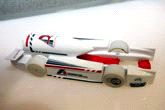LFP - Large-Format-Printing
Redline Racing speeds ahead with Fastest Car at F1 in Schools 2009 World Championship

Monday 02. November 2009 - Students use parts printed on the Alaris30 3D printer for accuracy, light weight and speed benefits
Redline Racing, a team of students from Trinity Christian School in Canberra, Australia, won the Fastest Car Award at the F1 in Schools 2009 Technology Challenge recently held in London. Competing against 31 finalists from 20 countries, the team also reached 2nd place overall at the World Championships in which students were judged on their design, development, engineering and presentation skills in their pursuit to develop a model F1 racing car.
The front and rear aerofoils and elements of the wheel mechanisms and axel supports of Redline Racing’s winning F1 car were produced using the Objet AlarisTM30 3D printer. “We can’t do more than that because of the rule restrictions,” explains Redline Racing team member Chris Law. According to F1 in Schools regulations, whilst the body of each car must be made from a single block of balsa wood other parts may be produced from other non-metallic materials.
“We used Objet printed components because a more accurate part can be produced using this technology than can be achieved with the balsa wood,” comments James Mazengarb, Redline Racing. Team-mate Alistair Smith elaborates, “The rules are very precise, cars can weigh a minimum of 55 grams with a +/-0.5 gram tolerance and wheels can have a minimum diameter of 26 mm with a +/- 0.1 mm tolerance. In order to attain the minimum possible weight and wheel size to gain extra speed, it’s critical that the parts are as accurate as possible, particularly to allow for the unexpected – for instance our cars each gained 0.3 grams in the transit from Australia.”
Comprising of Daniel Boucher, Annie Harper, Chris Law, James Mazengarb and Alistair Smith, the Redline Racing team clocked the fastest time of 1.055 seconds on the 20 meter time trial track. Although aiming for sub-one-second, the team won three out of three races and were satisfied with their accomplishment. “Although this is a slower track than others we’ve raced on, our times were fairly consistent and got faster each time, so we are happy with that result,” Law states.
The F1 car went through a rigorous and technical process, from the original design in CAD/CAM to manufacturing and testing. “By the time the car is manufactured and we go through aerodynamic testing, we can’t make any big changes because it’s too time consuming – except to the front and rear wings and the other printed parts because the 3D printing process is so quick,” Smith proclaims.
Printed parts were produced for Redline Racing by Objet dealer and distributor for Australia XYZ Innovations. Trinity Christian School teacher and supervisor of the Redline Racing team Graeme Hutton commented that XYZ Innovations had produced outstanding accuracy. The team also made their own tools for the project, including a static wheel balancer. Also printed on the AlaraisTM30 3D printer, the tool uses magnetism to test that wheels are perfectly balanced before they enter the F1 model car production line.
Trinity Christian School became involved with F1 in Schools Technology Challenge when parent Warren Smith, a senior lecturer in Aerospace, Civil and Mechanical Engineering at the University of New South Wales, suggested that they look for a competition to boost students’ interest in engineering. Now in their fourth year of the competition, Trinity Christian School have had a lot of success, also securing a place at the 2008 World Championship in Malaysia and winning silver.
